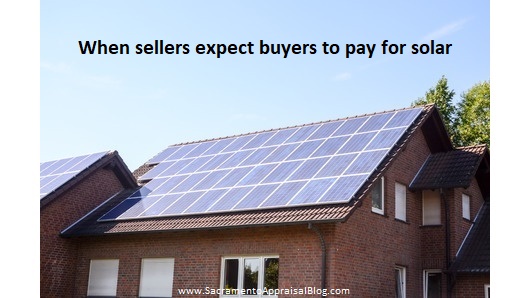Sellers often expect buyers to pay the full cost of a solar system. So they say, “I spent $30,000 on this system, so let’s price it $30,000 higher.” I get the sentiment, but is it reasonable? Let’s talk about it.

This isn’t a “how to value” solar post, but a conversation focused on some logical points that might help sellers see why buyers often don’t pay the full cost of an owned solar system in the resale market.
1) Location: I don’t doubt the value of solar, but I do doubt the market always recognizes the full cost of solar in the resale market. If a solar salesman says the value is always the same as the cost of the system, that sounds like a great sales pitch. Is it real though? Does it work in Alabama, Missouri, and Antarctica? Is it the same for a $75,000 house compared to $850,000? Probably not.
2) Dollar for dollar: It’s always the dream in real estate to get buyers to pay dollar for dollar for any home improvement done by sellers, but that’s not so easy to pull off. Even if you look at Remodeling Magazine’s 2018 Cost vs. Value Report, hardly any items on the list give close to a 100% return compared to the cost. Of course solar is different because it saves money, but there still might be a principle here worth considering.
3) Age of the system: Imagine a solar system that is built to last 20 years, and it’s now 5 years old. An owner says, “I know the system isn’t new, but I paid $40,000 for it, so a buyer should pay $40,000 too.” That’s a nice thought, but the system is 25% used up already, so why would a buyer pay the full cost of a brand new system? It would be like saying, “I realize my car is 5 years old, but I want you to pay the sticker price from the dealer because that’s what I paid.”
4) Rebates: Were there any rebates when the owner purchased the solar system? For instance, if there was a $5,000 rebate for a $25,000 system, that means the real cost of the system was $20,000. This is important because why would a buyer pay $25,000 if the seller technically paid $20,000? Moreover, newer systems are bound to be more efficient and maybe even less expensive, so why pay full cost for an older system?
5) Savings: Imagine an owner saves $150 per month on her energy bill for a solar system that cost $25,000. In this situation at $150 per month it would take 14 years to save the full $25,000. Would buyers pay upfront for 14 years worth of savings to keep $150 per month in their pocket? Are buyers even going to be in the property that long? Let’s remember the benefit of solar is realized over the course of two decades, so paying for all of that benefit in one instance may not reflect what most buyers are willing to do.
6) HUD solar programs: A home owner told a Realtor friend that HUD allows appraisers to add the cost of a solar system into the value. That sounds like an awesome idea, but it isn’t true. Appraisers don’t have a mandate from HUD or Fannie Mae to handle solar by adding the cost of the system to the value. What is true though is FHA allows owners and buyers to add solar on a purchase or refinance and get a loan (in some cases) for the full cost of the energy improvements. See page 453-454 in the HUD manual.
The puzzle of solar: This isn’t a post to explain how to value solar, but I hope some of the points above might bring perspective. In short, valuing solar is like a puzzle. We have to look to many pieces for the answer, so we’ll check out comps, consider the cost and age of the system, be in tune with how much money is saved each month, etc… If you think it would be useful, I can do a follow-up Q&A post about valuing solar (let me know).
I hope that was helpful.
Class I’m teaching: On September 17 I’m teaching my favorite class called “How to think like an appraiser“. I’d love to see you there.
Questions: What do you think of the points? Anything to add? What advice would you give to sellers expecting buyers to pay the full cost of solar?
If you liked this post, subscribe by email (or RSS). Thanks for being here.